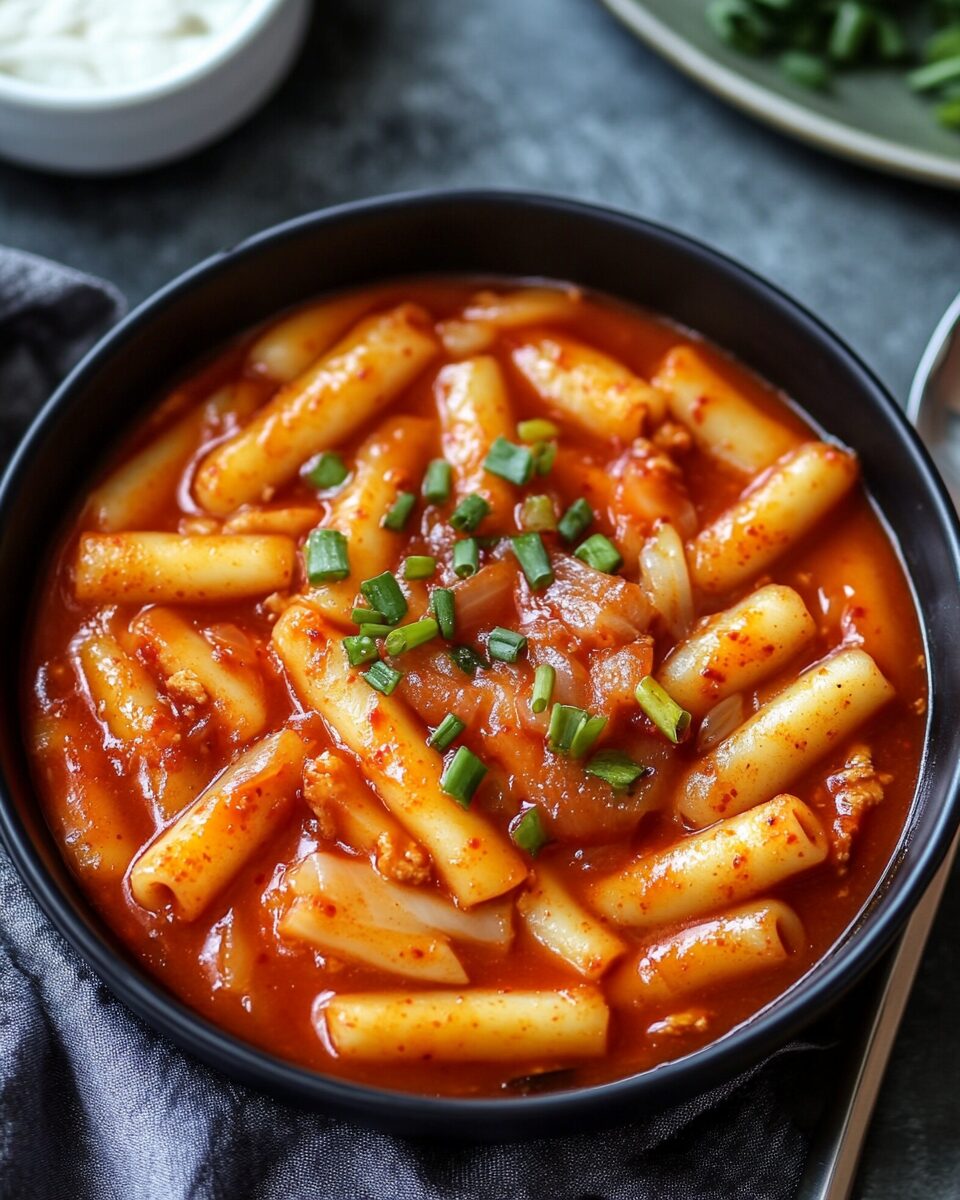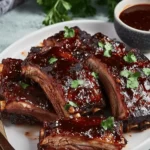Tteokbokki is a beloved Korean street food dish featuring chewy rice cakes and fish cakes bathed in a vibrant, spicy, and slightly sweet sauce. This comforting dish offers a delightful combination of textures and flavors, making it a favorite among many. It’s both filling and flavorful, perfect for those who enjoy a bit of heat in their meals.
FULL RECIPE:
Ingredients
- 2 cups Korean rice cakes (tteokbokki tteok)
- 3 cups anchovy stock or water
- 1 piece (3-inch) dried kelp (optional)
- 2 tablespoons gochujang (Korean red chili paste)
- 1 tablespoon gochugaru (Korean red chili flakes)
- 1 tablespoon soy sauce
- 1 tablespoon sugar
- 2 sheets Korean fish cakes, sliced into bite-sized pieces
- 2 green onions, chopped
- 1 teaspoon toasted sesame oil
- 1 teaspoon sesame seeds (optional)
Directions
-
Prepare the Stock: In a medium-sized pot, combine the anchovy stock and dried kelp. Bring to a boil over medium-high heat. Once boiling, remove the kelp and discard it.
-
Make the Sauce: To the boiling stock, add gochujang, gochugaru, soy sauce, and sugar. Stir until the gochujang dissolves completely, creating a smooth sauce.
-
Cook the Rice Cakes: Add the rice cakes to the sauce and let them cook for 8-10 minutes, stirring frequently to prevent sticking, until they become soft and chewy.
-
Add Fish Cakes: Introduce the sliced fish cakes to the pot and cook for an additional 4 minutes, allowing them to absorb the flavors of the sauce.
-
Finish with Aromatics: Stir in the chopped green onions and drizzle the toasted sesame oil over the dish. Mix well to combine all the flavors.
-
Serve: Transfer the tteokbokki to a serving dish and garnish with sesame seeds if desired. Enjoy it hot.
Nutrition Facts
- Calories: 400 kcal
- Carbohydrates: 80g
- Protein: 10g
- Fat: 5g
- Saturated Fat: 1g
- Cholesterol: 0mg
- Sodium: 800mg
- Fiber: 2g
- Sugar: 10g
The History and Origins of Tteokbokki
Tteokbokki is one of Korea’s most beloved street foods, enjoyed by people of all ages. The origins of this dish can be traced back to the Joseon Dynasty, where a version called gungjung tteokbokki (royal court rice cakes) was served to the royal family. This early form of tteokbokki was not spicy and was instead stir-fried with soy sauce, vegetables, and beef, making it a refined and savory dish. The modern spicy tteokbokki that is widely recognized today became popular in the mid-20th century when gochujang (Korean red chili paste) was introduced into the recipe. This transformed the dish into a bold and fiery delicacy that captured the hearts of Korean street food lovers. Since then, tteokbokki has continued to evolve, with variations that include cheese, seafood, and even black bean sauce.
Why Tteokbokki is So Popular
One of the reasons for tteokbokki’s immense popularity is its chewy texture and rich, spicy flavor. The rice cakes (tteok) are soft yet satisfyingly chewy, making them a unique eating experience. When combined with the deep umami of anchovy stock and the heat of gochujang, the result is a dish that is both comforting and exciting. Tteokbokki is widely available in Korea, from street food stalls to high-end restaurants. It’s also incredibly affordable, making it a favorite for students and young professionals looking for a quick and delicious meal. The dish has also gained international recognition, with Korean restaurants worldwide adding tteokbokki to their menus.
Different Variations of Tteokbokki
Although the classic tteokbokki is made with rice cakes, fish cakes, and a spicy red sauce, there are many regional and creative variations of the dish:
- Gungjung Tteokbokki – A non-spicy version made with soy sauce, vegetables, and sometimes beef or mushrooms.
- Cheese Tteokbokki – A modern twist that includes melted cheese for a creamy, rich flavor.
- Rosé Tteokbokki – A fusion version that blends gochujang with heavy cream, creating a creamy and mildly spicy sauce.
- Seafood Tteokbokki – Includes shrimp, squid, mussels, or other seafood, adding a deep oceanic flavor.
- Curry Tteokbokki – A flavorful twist that combines curry powder with the traditional sauce.
- Black Bean Tteokbokki – Uses Korean black bean paste (jajang) instead of gochujang for a savory, umami-packed alternative.
Pairing Tteokbokki with Other Korean Dishes
Tteokbokki is often enjoyed as a standalone meal, but it pairs exceptionally well with other Korean dishes:
- Kimbap – This seaweed rice roll is a perfect complement to tteokbokki, balancing its spiciness with mild and savory flavors.
- Eomuk (Fish Cakes on Skewers) – Often served alongside tteokbokki, eomuk is soaked in a warm broth, creating a satisfying contrast.
- Twigim (Korean Tempura) – Deep-fried vegetables and seafood add a crispy texture that contrasts beautifully with the chewy rice cakes.
- Sundae (Korean Blood Sausage) – A traditional street food often eaten with tteokbokki for a more filling meal.
Tips for Making the Best Tteokbokki
If you want to make restaurant-quality tteokbokki at home, here are some expert tips to get the best results:
- Use Fresh or Well-Soaked Rice Cakes: If you’re using frozen rice cakes, make sure to soak them in warm water for about 20-30 minutes before cooking to soften them.
- Balance the Sweetness and Spiciness: Adjust the sugar and gochujang levels to match your taste preference. Some people prefer a milder version, while others enjoy extra heat.
- Simmer for the Right Amount of Time: Overcooking the rice cakes can make them too soft, while undercooking leaves them too chewy. Around 8-10 minutes is the perfect time for ideal texture.
- Use Anchovy Stock for Authentic Flavor: While water can be used, anchovy stock adds an authentic depth of flavor that enhances the dish.
- Don’t Forget the Sesame Oil: A drizzle of toasted sesame oil at the end adds an extra layer of aroma and richness.
Cultural Significance of Tteokbokki
Tteokbokki holds a special place in Korean culture. It is commonly eaten during gatherings with friends and family, especially in casual settings like street markets and food courts. Many Koreans have nostalgic memories of eating tteokbokki after school or enjoying it as a late-night snack. The dish is also celebrated during Korean street food festivals, where vendors compete to make the best version, showcasing new and innovative takes on the classic recipe.
Conclusion
Tteokbokki is much more than just a spicy rice cake dish—it is a cultural icon that represents the vibrancy and warmth of Korean cuisine. Its rich history, versatile variations, and bold flavors make it a must-try dish for anyone interested in Korean food. Whether you prefer the classic spicy version, a cheesy indulgence, or a fusion twist, tteokbokki offers something for everyone. By experimenting with different ingredients and flavors, you can customize this dish to your taste and enjoy a delicious Korean comfort meal in your own home. If you haven’t tried tteokbokki yet, now is the perfect time to give it a go! With its easy-to-follow recipe and rich flavors, it’s no wonder why this dish remains one of Korea’s most loved and internationally recognized foods.






